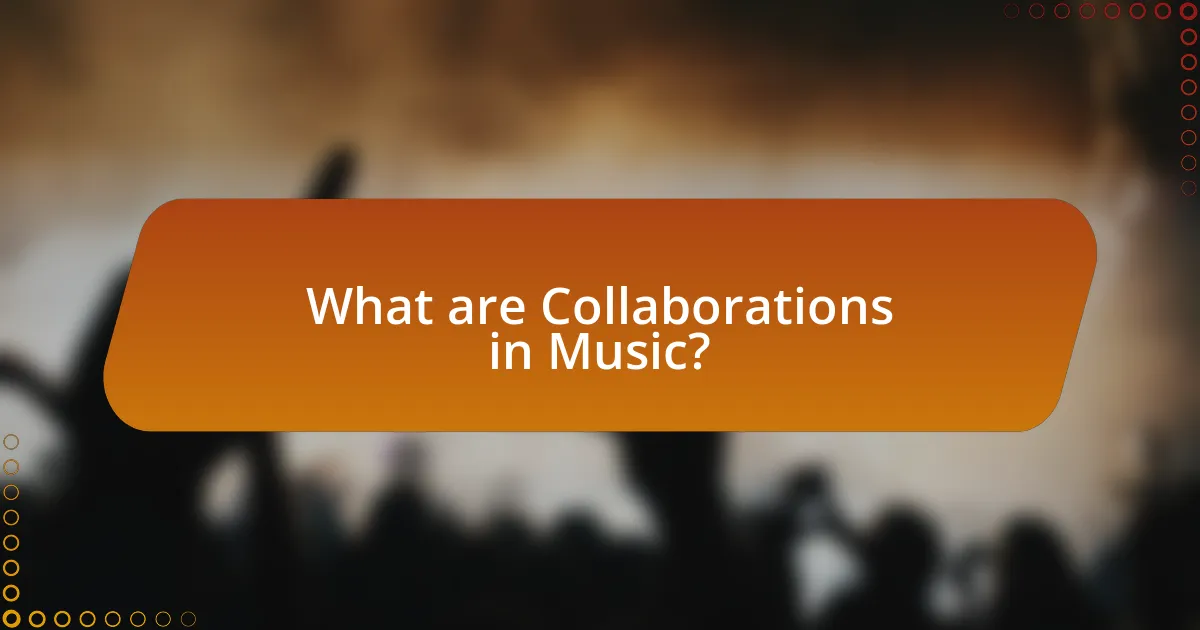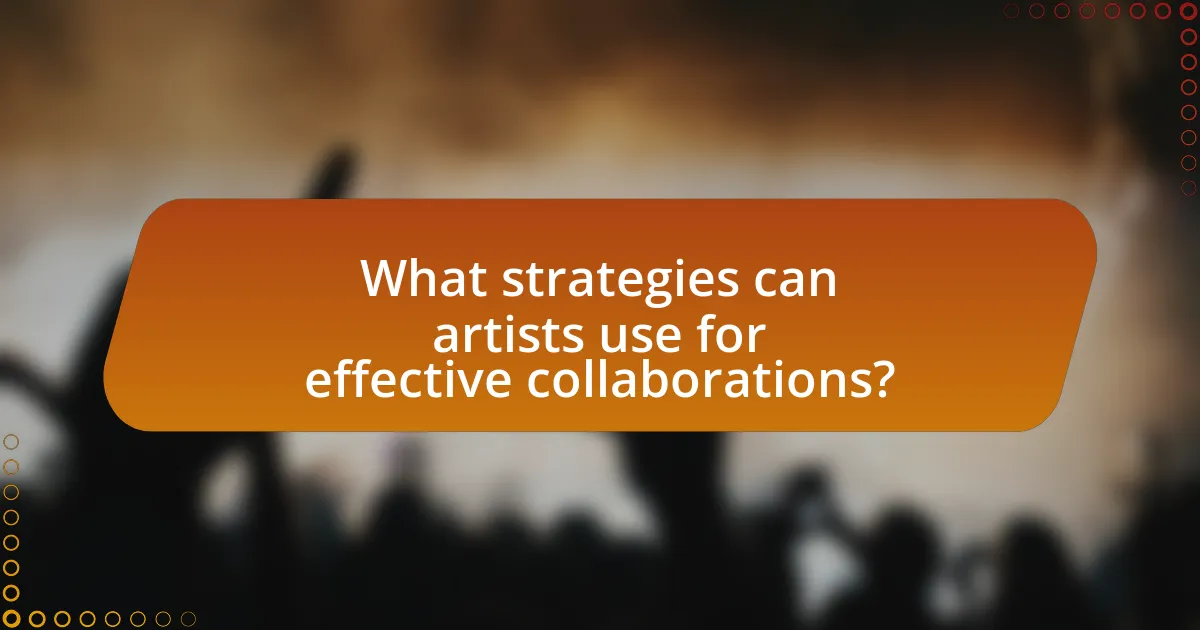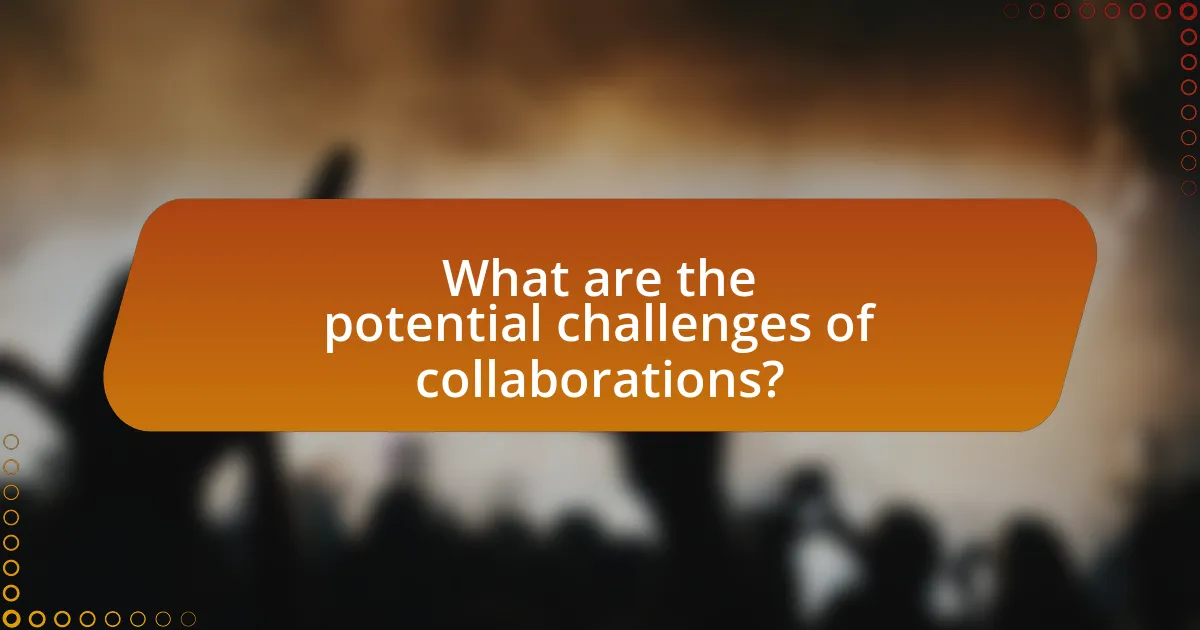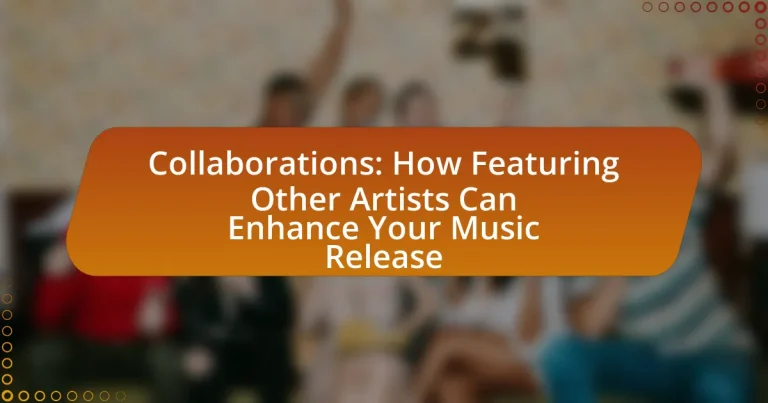Collaborations in music involve two or more artists working together to create a song or project, allowing for the blending of styles and broader audience reach. This article explores how collaborations enhance music releases by increasing visibility and introducing innovative sounds, as evidenced by successful partnerships like Jay-Z and Linkin Park. It also examines different types of collaborations, their impact on the creative process, and the importance of clear communication and mutual respect among artists. Additionally, the article addresses potential challenges and pitfalls in collaborations, offering strategies for effective partnerships and promotion of collaborative work.

What are Collaborations in Music?
Collaborations in music refer to the process where two or more artists work together to create a song or musical project. This practice allows artists to blend their unique styles, reach wider audiences, and enhance the creative process. For instance, collaborations can lead to innovative sounds and increased visibility, as seen in successful partnerships like Jay-Z and Linkin Park’s “Collision Course,” which combined hip-hop and rock elements, resulting in significant commercial success.
How do collaborations enhance music releases?
Collaborations enhance music releases by broadening the audience reach and combining diverse artistic styles. When artists collaborate, they leverage each other’s fan bases, which can lead to increased visibility and streaming numbers. For instance, a study by Nielsen Music found that collaborations often result in higher chart positions, as seen with tracks like “Sicko Mode” by Travis Scott featuring Drake, which achieved significant commercial success due to the combined popularity of both artists. Additionally, collaborations can introduce new sounds and creative influences, enriching the overall quality of the music and appealing to a wider range of listeners.
What are the different types of collaborations in music?
Different types of collaborations in music include featured artists, songwriting partnerships, production collaborations, and cross-genre collaborations. Featured artists contribute vocals or instrumental parts to a track, enhancing its appeal; for example, the collaboration between Ed Sheeran and Justin Bieber on “I Don’t Care” showcases this type. Songwriting partnerships involve multiple songwriters working together to create a piece, as seen in the collaboration between Max Martin and various artists. Production collaborations occur when producers work together to create a sound, such as the partnership between Pharrell Williams and Chad Hugo in The Neptunes. Cross-genre collaborations blend styles from different musical genres, exemplified by Lil Nas X’s “Old Town Road,” which fuses country and hip-hop. Each type of collaboration can significantly enhance the reach and impact of a music release.
How do collaborations influence the creative process?
Collaborations significantly enhance the creative process by introducing diverse perspectives and skills that can lead to innovative ideas. When artists work together, they combine their unique strengths, which can result in a richer and more varied output than what each could achieve individually. For instance, a study published in the Journal of Creative Behavior found that collaborative environments often stimulate creativity by fostering open communication and idea exchange, leading to higher-quality artistic products. This synergy not only broadens the creative scope but also encourages experimentation, ultimately enriching the final work.
Why are collaborations important for artists?
Collaborations are important for artists because they expand creative possibilities and reach a broader audience. By working with other artists, musicians can blend different styles and ideas, leading to innovative and unique works that may not have been possible individually. For instance, a study by the University of Southern California found that collaborations can increase an artist’s visibility and fan engagement, as they tap into each other’s fan bases, resulting in a significant boost in streams and sales. This synergy not only enhances the artistic output but also fosters community within the music industry, making collaborations a vital strategy for success.
What benefits do artists gain from featuring other musicians?
Artists gain increased exposure and access to new audiences by featuring other musicians. Collaborating with another artist allows for cross-promotion, where both parties can share their fan bases, leading to a broader reach. For instance, a study by Nielsen Music found that collaborations can lead to a significant increase in streaming numbers, as fans of both artists are likely to engage with the new release. Additionally, featuring other musicians can enhance the creative process, allowing artists to blend different styles and ideas, which can result in innovative music that appeals to a wider demographic.
How can collaborations expand an artist’s audience?
Collaborations can expand an artist’s audience by leveraging the fan bases of both artists involved. When two artists collaborate, they introduce each other to their respective audiences, which can lead to increased exposure and new followers. For instance, a study by Nielsen Music found that collaborations often result in higher streaming numbers, as fans are more likely to engage with content that features their favorite artists alongside others they may not yet know. This cross-pollination of audiences can significantly enhance an artist’s reach and visibility in the music industry.

What strategies can artists use for effective collaborations?
Artists can use clear communication, mutual respect, and defined roles to ensure effective collaborations. Clear communication establishes expectations and fosters a productive environment, while mutual respect encourages creativity and openness to ideas. Defining roles helps streamline the collaborative process, allowing each artist to contribute their strengths effectively. Research indicates that successful collaborations often result from these strategies, as they enhance trust and synergy among artists, leading to more innovative outcomes.
How should artists choose collaborators?
Artists should choose collaborators based on shared artistic vision and complementary skills. A strong alignment in creative goals ensures that the collaboration enhances the overall project, while diverse skills can bring new perspectives and innovation. For instance, a singer-songwriter may benefit from collaborating with a producer who specializes in electronic music, thereby expanding their sound. Research shows that successful collaborations often lead to increased audience reach and engagement, as seen in the rise of genre-blending music that attracts diverse listener demographics.
What factors should be considered when selecting a collaborator?
When selecting a collaborator, factors such as complementary skills, shared vision, and mutual respect should be considered. Complementary skills ensure that each collaborator brings unique strengths to the project, enhancing the overall quality of the work. A shared vision aligns both parties on the project’s goals and creative direction, which is crucial for cohesive output. Mutual respect fosters a positive working relationship, facilitating open communication and collaboration. Research indicates that successful collaborations often stem from these foundational elements, as they contribute to a productive and harmonious creative environment.
How can artists ensure a good fit with potential collaborators?
Artists can ensure a good fit with potential collaborators by clearly defining their artistic vision and goals before initiating collaboration. This clarity allows artists to identify collaborators whose styles, values, and objectives align with their own, fostering a productive partnership. Research indicates that successful collaborations often stem from shared creative interests and complementary skills, which enhance the overall quality of the project. For instance, a study published in the Journal of Creative Behavior highlights that artists who engage in thorough discussions about their artistic direction and expectations are more likely to achieve satisfying collaborative outcomes.
What are the best practices for collaborating on a music release?
The best practices for collaborating on a music release include clear communication, defined roles, and mutual respect among all artists involved. Clear communication ensures that all parties understand the vision, expectations, and contributions required for the project. Defined roles help streamline the creative process, allowing each artist to focus on their strengths, whether in songwriting, production, or promotion. Mutual respect fosters a positive working environment, encouraging creativity and collaboration. Additionally, establishing a timeline and setting deadlines can enhance productivity and keep the project on track. These practices are supported by successful collaborations in the music industry, where artists like Jay-Z and Kanye West have demonstrated the importance of effective communication and role clarity in their joint projects.
How can communication improve collaboration outcomes?
Effective communication enhances collaboration outcomes by ensuring that all parties involved have a clear understanding of their roles, expectations, and objectives. When artists communicate openly about their creative visions, project timelines, and feedback, it fosters a collaborative environment where ideas can be shared freely. Research indicates that teams with strong communication practices are 25% more productive, as they can resolve misunderstandings quickly and align their efforts towards common goals. This clarity not only improves the quality of the final product but also strengthens relationships among collaborators, leading to more successful and enjoyable music releases.
What roles do contracts and agreements play in collaborations?
Contracts and agreements serve as essential frameworks in collaborations by clearly defining the roles, responsibilities, and expectations of all parties involved. These legal documents help prevent misunderstandings and disputes by outlining terms such as compensation, intellectual property rights, and project timelines. For instance, a well-drafted contract can specify how revenue from a music release will be shared among collaborating artists, ensuring transparency and fairness. Additionally, agreements can protect the creative contributions of each artist, safeguarding their rights and contributions in the collaborative process. This structured approach not only fosters trust but also enhances the overall effectiveness of the collaboration, leading to successful outcomes in music releases.

What are the potential challenges of collaborations?
The potential challenges of collaborations include miscommunication, differing artistic visions, and logistical issues. Miscommunication can lead to misunderstandings about roles, expectations, and contributions, which may hinder the creative process. Differing artistic visions can create conflicts, as collaborators may have unique styles or goals that do not align, resulting in a final product that lacks cohesion. Logistical issues, such as scheduling conflicts and resource allocation, can also impede progress and lead to frustration among collaborators. These challenges are commonly reported in collaborative projects across various creative fields, highlighting the importance of clear communication and alignment of goals to ensure successful outcomes.
What common pitfalls should artists avoid in collaborations?
Artists should avoid lack of clear communication in collaborations. Clear communication ensures that all parties understand their roles, expectations, and creative visions, which is crucial for a successful partnership. Misunderstandings can lead to conflicts, dissatisfaction, and ultimately, a failed collaboration. Additionally, artists should steer clear of not establishing boundaries regarding creative input and decision-making, as this can result in one party feeling overshadowed or unappreciated. Furthermore, failing to discuss and agree on financial arrangements upfront can lead to disputes later on, undermining the collaboration’s success. These pitfalls are commonly observed in collaborative projects and can significantly impact the outcome of the artistic endeavor.
How can creative differences impact a collaboration?
Creative differences can significantly impact a collaboration by influencing the direction and outcome of the project. When artists have varying visions, styles, or approaches, it can lead to innovative ideas that enhance the final product, fostering a unique blend of creativity. However, these differences can also result in conflicts, miscommunication, and delays if not managed effectively. Research indicates that diverse perspectives can improve problem-solving and creativity, as seen in a study published in the Journal of Creative Behavior, which found that teams with varied backgrounds produced more original ideas. Thus, while creative differences can be a source of tension, they can also drive artistic growth and lead to a richer collaborative experience.
What are the risks of miscommunication in collaborative projects?
The risks of miscommunication in collaborative projects include project delays, misunderstandings of roles, and compromised quality of the final output. These issues arise when team members fail to share clear and consistent information, leading to confusion about tasks and expectations. For instance, a study published in the Journal of Business Communication found that 70% of project failures are attributed to poor communication among team members. This statistic underscores the critical importance of effective communication in ensuring that all collaborators are aligned and working towards the same goals.
How can artists overcome challenges in collaborations?
Artists can overcome challenges in collaborations by establishing clear communication and setting defined roles from the outset. Effective communication ensures that all parties understand their contributions and expectations, reducing misunderstandings. Research indicates that projects with well-defined roles and open dialogue experience higher satisfaction rates among collaborators, as seen in studies on team dynamics in creative industries. By fostering an environment of trust and respect, artists can navigate differing artistic visions and work towards a cohesive final product.
What strategies can be employed to resolve conflicts?
Effective strategies to resolve conflicts include open communication, active listening, and seeking common ground. Open communication allows all parties to express their viewpoints clearly, which is essential for understanding differing perspectives. Active listening involves fully concentrating on what is being said, ensuring that each party feels heard and valued. Seeking common ground helps identify shared interests or goals, facilitating a collaborative approach to conflict resolution. Research indicates that these strategies can lead to more constructive outcomes, as they promote empathy and cooperation among conflicting parties.
How can artists maintain a positive working relationship with collaborators?
Artists can maintain a positive working relationship with collaborators by fostering open communication and mutual respect. Establishing clear expectations from the outset helps prevent misunderstandings, while regular check-ins ensure that all parties remain aligned throughout the collaboration process. Additionally, actively listening to each other’s ideas and feedback promotes a sense of partnership and creativity. Research indicates that effective communication is a key factor in successful collaborations, as highlighted in a study by the Journal of Business Communication, which found that teams with strong communication practices are 25% more productive.
What are some practical tips for successful music collaborations?
Successful music collaborations require clear communication, mutual respect, and defined roles. Establishing open lines of communication ensures that all parties understand their contributions and expectations, which fosters a collaborative environment. Mutual respect among collaborators enhances creativity and encourages diverse ideas, leading to innovative outcomes. Additionally, defining specific roles and responsibilities helps streamline the creative process, allowing each artist to focus on their strengths. Research indicates that successful collaborations often result from artists who actively listen to each other and adapt their styles, which can lead to unique musical fusions that resonate with audiences.
How can artists effectively promote their collaborative work?
Artists can effectively promote their collaborative work by leveraging social media platforms, engaging in cross-promotion, and utilizing targeted marketing strategies. Social media allows artists to reach wider audiences by sharing content related to their collaboration, such as behind-the-scenes footage, teasers, and promotional posts. Cross-promotion involves both artists sharing the collaborative work on their respective channels, which can significantly increase visibility and engagement. Targeted marketing strategies, such as email newsletters and ads aimed at specific demographics, can further enhance reach and impact. According to a study by the International Journal of Music Business Research, collaborations can increase audience engagement by up to 50%, demonstrating the effectiveness of these promotional methods.
What tools and platforms can facilitate collaboration in music?
Tools and platforms that facilitate collaboration in music include Soundtrap, BandLab, and Splice. Soundtrap is a cloud-based digital audio workstation that allows multiple users to create and edit music in real-time, making it ideal for remote collaboration. BandLab offers similar features, enabling musicians to record, mix, and share their projects with others seamlessly. Splice provides a vast library of samples and allows users to collaborate on projects by sharing files and ideas, enhancing the creative process. These platforms are widely used in the music industry, demonstrating their effectiveness in fostering collaboration among artists.


